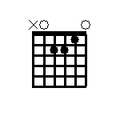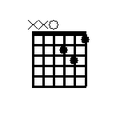Guitar/Open Chords
Open chords are chords that include unfretted strings of the guitar. Open chords contain one or more open strings. For example the Em chord diagram on this page shows 4 open strings but the D major chord diagram only has 1 open string. They are both classed as "open chords".
Open chords are the easiest chords to play on the guitar and many famous songs can be played using just 3 or 4 open chords. Learning a handful of open chords at the first position (first four frets) and memorizing their shape is an important step towards mastering barre chords.
When you strum any chord, all of the strings (open and fretted) should ring out clearly. If any of the strings cannot be heard; check to make sure that you are not stopping any string from sounding. If you are accidentally muting any strings, arch your hand more and curl your fingers to ensure that it is the tip of the finger pressing the string and not the flat of the finger.
Major Chords
[edit | edit source]Major chords are defined by the major triad. The major triad consists of three notes which are spaced at specific intervals. In ascending order: the root, major third and perfect fifth. These intervals are also found between the first note of a major scale and the third note (major 3rd), and the first note and the fifth note (fifth). When combined they have a bright happy tone, and are often used in upbeat music.
There are 6 major chords commonly used in the open position; A, C, D, E, F and G. The standard tuning of a guitar is designed so that chords can be easily played. Beginners often find the G major and the F major shape challenging to play but a small amount of extra practice overcomes any initial difficulties.
E Major
[edit | edit source]Many early blues songs are written with E major as the root chord. The chord contains the notes E, G#, and B, and can be played with three fingers.
Fingering 1: (o231oo)
First, place your second finger on the second fret of the fifth string. The string now plays a B note. Then, place your third finger on the second fret of the fourth string. This note is an E, which is an octave higher than the open sixth string. Finally, place your first finger on the first fret of the third string. You can alternatively switch the second and third fingers.
When you strum this chord, all of the strings should ring out clearly. If any string sounds dull or muffled, check to see that you are not accidentally touching strings, and that all the strings are pressed firmly against their frets. It is important to build good technique early, as bad habits tend to linger. Make sure that your fingers are arched on your left hand, and that your thumb is positioned to give you a strong grip.
A Major
[edit | edit source]There are several ways to play A major. You should learn how to play all of them, then use the most suitable to each musical context. In an A major, the notes are A, C# and E. When playing an A, it is considered good form not to let the low E string ring out. While an E is one of the notes in the A major chord, playing an E below the other notes puts this A major in second inversion. This changes the tone of the chord, and may not achieve the desired effect.
Fingering: (xo123o)
Put your first, second, and third finger on the second fret of the fourth, third and second strings respectively. When you strum, ensure that all strings sound clear, except for the sixth string which should be muted. This is probably the most popular fingering, but is tough for people with thick fingers. (xo213o) is a variation by switching the first and second finger, with the second on the third string, first for fourth string, third for fifth string.
Alternatively you can finger this chord (xo112o), this requires that the first finger fret two strings (using the finger's pad rather than the tip). This leaves two fingers free and is often favoured by classical and flamenco performers, depending on musical context.
(xo234o) fingering allows for easy transition into higher position barre chords,
(xo231o) fingering allows for easy transition from open E, makes a transition from A to Amin a breeze (great if A is the IV chord), and is more comfortable for some with chubby fingers.
Finally, (xo111o) by using one of your fingers, most commonly the first or third finger, and barre the aforementioned frets. This one is tough for beginners, but easier for players with large hands. For more information on barring, see the section on barre chords.
D Major
[edit | edit source]Fingering: (xxo132)
Use your first finger on the third string, third finger on the second string, and your second finger on the first string. Be careful not to play the sixth and fifth strings, since they are not required for this chord. At first this may feel awkward, but it will be comfortable to play. Watch that you keep your thumb low when you play this chord. To play D minor, try the most common fingering (xxo231), with your first finger on the first fret of the first string, third finger on the third fret of the second string, and your second finger on the second fret of the third string. You can also try to finger the D major chord as (xxo243), which will help you to later use this as a barred, movable chord shape.
G Major
[edit | edit source]-
three finger method
-
four finger method
There are two common ways to play a G major, a three finger method (Frets: 320003) and a four finger method (Frets: 320033), both with a slight difference in sonority. In either way, the notes are a combination of G, B and D. From this point forward, the fingerings will be shown in parentheses for the sake of simplicity.
Fingering 1: (32ooo4)
Put your third finger on the sixth string, second finger on the fifth string, and fourth finger on the first string. This is a favorite among beginners, and it allows for easy change to the open C major chord. Alternatively you can finger it (21ooo3), which may be easier for players with small hands or guitars with small necks and is recommended when changing to or from a open D7 chord.
Fingering 2: (21oo34)
This uses all four fingers and makes for an easy G to D major chord change. This has a more "stable" sound than the first fingering because the note played on the open B string is a D therefore avoiding the doubling of the third. Don't worry if that explanation isn't clear; just remember the difference between the two chords (one has a doubled third). The theory of chords and how they are constructed from the intervals of a scale is a subject that requires some off-the-guitar learning but with applied study can be easily understood.
C Major
[edit | edit source]Fingering: (x32o1o)
This is the most common fingering. Alternatively, you can use (x42o1o). (x32o14) or (x32o13) provide C chords with different voicings.
F Major
[edit | edit source]Fingering: (xx3211)
To play this, use the pad of your first finger, and press the first and second strings down at the first fret. You need to press firmly, or the strings will not ring out properly. Then take your second finger and put it on the third string, and put your third finger on the fourth string. The fifth and sixth strings should not be played with this chord.
Minor Chords
[edit | edit source]Minor chords use the first, third and fifth of the minor scale. They have a dark, melancholic tone and are most often used in darker music.
E Minor
[edit | edit source]Fingering: (o23ooo)
Alternatively you can finger this chord (o22ooo). For variation you can also add a G on the high E string, and play the cord using these frets: (o22oo3).
A Minor
[edit | edit source]Fingering 1: (xo221o)
You can also finger this like (xo342o).
D Minor
[edit | edit source]Fingering 1: (xxo231)
Also often fingered using the fourth finger in the place of the third. Make sure your first finger does not "fold". If you are doing it, you will know what I mean because your first finger will hurt around the joints. The proper technique should apply to this chord just as much as any other. Keep your thumb back.
Other kinds of chords
[edit | edit source]There are a variety of other chords that can be played in open position, and often it involves taking a chord you are already familiar with and adding or removing a finger. Experimentation can yield a lot of interesting sounds, and you are only limited by your imagination when it comes to using them.
Dominant-type seventh chords
[edit | edit source]Dominant-type seventh chords are notated as A7, C7 etc. They add an extra note to a major chord. The extra note is found at an interval of a minor seventh above the root note of the chord. For example, a D chord major would contain a D, an F#, and an A making the intervals 1,3,5. A D7 adds a C to these notes resulting in 1,3,5,minor7. The minor seventh interval can be easily found by an alternative method. Take any chord, and lower one of the root notes downwards in pitch by two frets (a whole step) to locate the minor 7th. The chord will usually sound more settled if the root remains as the bass note of the chord, so a root note higher than the bass is the better choice to alter. The chords already shown above all allow you to do this. Below are some chord shapes you should know. These are only the open sevenths, which are easier than others covered in the barre chords section.
D7
Notice how we moved the octave D from the D major chord (third fret second string) down two frets, making it the minor 7th. That's pretty much what we are going to do with all the other 7th chords. You can take any chord and, by moving one of the root notes down two frets, find the minor 7th.
E7
Easy, and again, we moved the octave E down two frets.
A7
Same again.
G7
A bit unfriendly. Remember, it is not much different from a C chord shape, except you stretch more.
B7
This one looks funny, but you will use it a lot in songs in the key of E major, which is the natural key of the guitar.

















